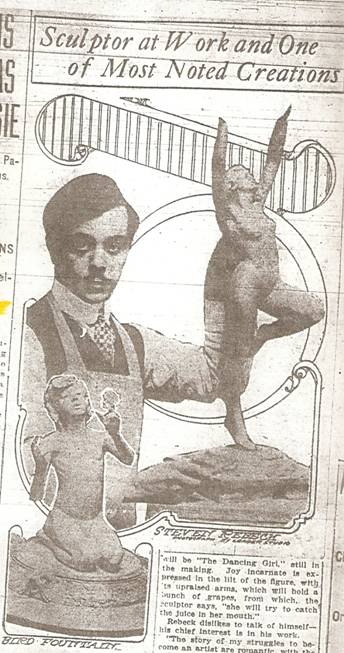

Found in the Cleveland Institute of Art’s Scrapbook
Carves Visions of Boyhood as Ragged Newsie
Sculptor Who Used to Sell Papers in Cleveland Returns From Studies to Open Studio
WORK IS POPULAR AMONG FASHIONABLE ART PATRONS
Critics Praise Finish and Feeling Displayed in Creations of Steven Rebeck
By Annabel Sharp
In his studio at E. 11th St. and Euclid Ave., Cleveland’s most promising young sculptor is working out the visions of beautiful, elusive figures that came to him when he was a hungry little street urchin, twelve years ago.
He is Steven Rebeck, twenty-three years old. Thrown on his own resources when he was a youngster, making his living selling papers and as errand boy, the desire to achieve something better caused him to spend his evenings copying old cartoons by the light of a flickering oil lamp, in his attic-room. The copies grew characterful and inspired the admiration of his boy friends.
Traveled Hard Road
From those rude cartoons to the Rodinesque fountain he has just completed and now is casting in his studio the young man has traveled over a long, uphill road of constant study.
Through the interest of Price McKinney, who saw his first work produced under Herman Matzen at the Cleveland School of Art, he was enabled to complete the four-year course there and to study two years in New York.
Now that he has opened his studio in partnership with Joseph Motto, also a clever sculptor, the fashionable art patrons of Cleveland have flocked to the place, and are ordering fountains for Italian gardens, reliefs by way of portraits of themselves, and the charming small figures that Rebeck delights to make.
Mrs. Max McMurray, herself a sculptor of ability, is a frequent visitor at the studio and has praised the finish and the feeling of the work of Rebeck.
What he expects to be one of the most effective of his recent statues will be “The Dancing Girl,” still in the making. Joy incarnate is expressed in the lilt of the figure, with its upraised arms, which will hold a bunch of grapes, from which, the sculptor says, “she will try to catch the juice in her mouth.”
Rebeck dislikes to talk of himself—his chief interest is in his work.
“The story of my struggles to become an artist are romantic, with the proverbial attic and all,” he admits, “but I want the work to speak for itself—everything that I think or want to express I put into that,” he declares.
